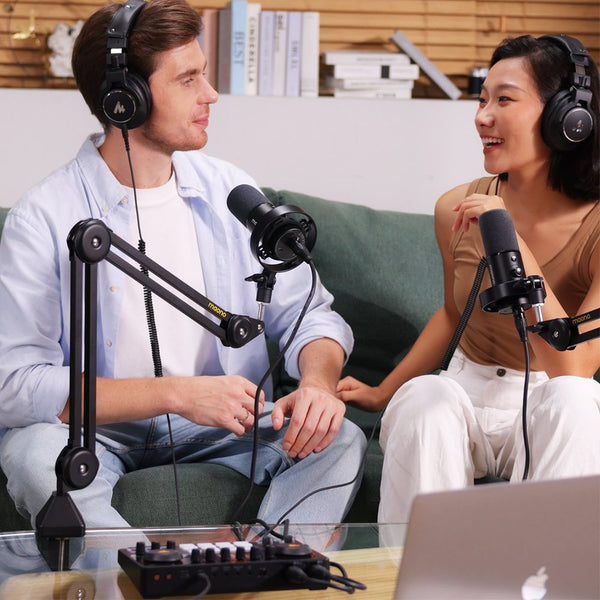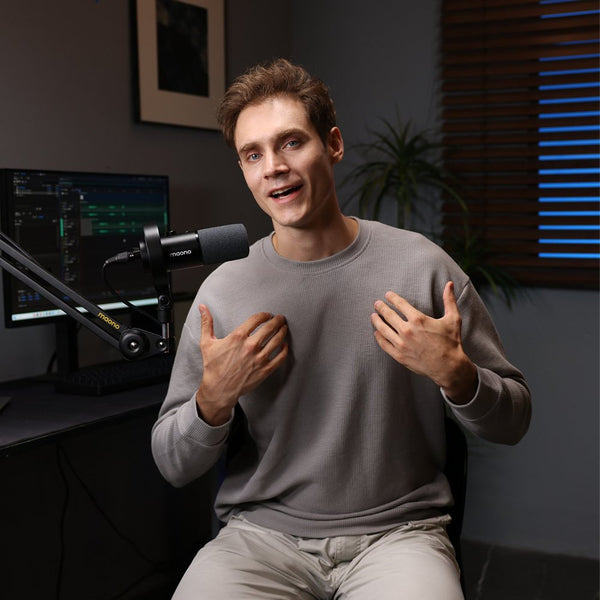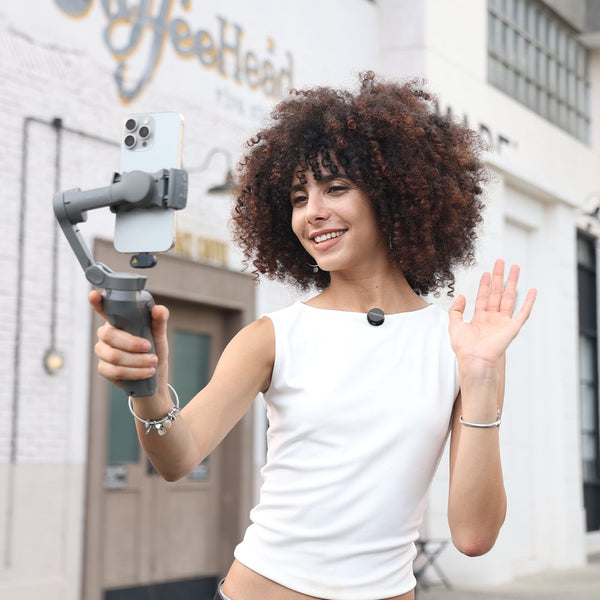The scent of good aromatics can uplift your mood, and what if you could make your own in the comfort of your home? This would be great content for your vlog if you’re planning to start one. Now, let’s explore which type of wireless microphone is ideal for a perfume-making vlog, especially if you’re just a beginner.
Whether you're just looking around or want to learn something new, it's worth the read. So, let's get started.
The art of perfume-making has fascinated people for centuries. Today, with the rise of YouTube, TikTok, and other video platforms, many enthusiasts are turning their passion for crafting scents into vlogs. These videos not only showcase creativity but also invite viewers to experience the process of blending oils, alcohols, and natural essences.
But here’s a crucial detail: great visuals alone won’t make your vlog engaging. Viewers need clear audio to follow your explanations, enjoy the subtle ASMR-like sounds of mixing, and connect with your storytelling. This is where using a wireless microphone—or even the best lavalier microphone—becomes essential. Unlike built-in camera mics that pick up background noise, a wireless mic allows you to capture your voice clearly, even when you’re moving around your workspace.
In this guide, we’ll explore the tools and ingredients you need as a beginner perfumer, provide a step-by-step process for making your own signature perfume, share vlogging tips with wireless microphones, and answer common questions about both perfume-making and audio recording.

Essential Tools & Ingredients for Beginner Perfumers (and How to Record Them Clearly)
If you’re just starting out, you don’t need a professional lab. A few essential tools will set the stage for your perfume-making journey:
-
Essential oils or fragrance oils – the heart of your perfume, providing top, middle, and base notes.
-
Carrier oils (like jojoba or almond oil) – used for oil-based perfumes.
-
Alcohol (high-proof, unscented) – often used as a base for spray perfumes.
-
Glass bottles and droppers – for accurate measuring and storing.
-
Blotter strips – to test scents before combining.
-
Notebook – to record your blends and adjustments.
Recording tip: When showcasing these tools, place your wireless mic (like the Maono Wave T5) close to your chest to capture your narration while your hands remain free to demonstrate. If you’re still searching online for options, you can simply look up lavalier mic near me to find budget-friendly choices that suit your setup.

Step-by-Step Guide to Crafting Your Own Signature Perfume at Home
-
Choose your fragrance notes: Select a balance of top (citrus, herbal), middle (floral, spicy), and base notes (woody, musky).
-
Experiment with ratios: A common beginner formula is 30% top, 50% middle, 20% base.
-
Blend small batches: Start with drops in a small vial, adjusting until you like the combination.
-
Dilute with alcohol or carrier oil: This transforms concentrated oils into wearable perfume.
-
Let it rest: Store your blend in a cool, dark place for at least 48 hours to allow the scents to meld.
-
Test and refine: Apply on your skin to evaluate longevity and scent evolution.
Vlogging tip: As you pour and mix, use a mini wireless mic like the Maono Wave T1 clipped to your shirt. This captures the subtle sounds of droplet falls and bottle clinks—perfect for viewers who love sensory details. A good lavalier microphone will ensure every whisper and sound effect feels immersive.

Capturing ASMR Scents: Wireless Mic Tips for Recording Perfume-Making Sounds
Perfume-making naturally creates soft, satisfying sounds: liquid pouring, droppers clicking, caps twisting. Highlighting these adds an ASMR effect to your vlog.
-
Use a lavalier mic for close-up sound capture.
-
Keep background noise low—turn off fans or noisy appliances while filming.
-
Record in segments: capture ASMR sounds separately, then overlay them in editing for a polished experience.
-
Experiment with placement: try moving the wireless mic closer to the tools when emphasizing specific sounds.
If you’re on a tight budget, consider the best budget lavalier microphone options. They provide solid quality without breaking the bank.
Top Mistakes Beginners Make in Perfume Making (and How to Avoid Them)
-
Overusing strong oils – Some scents overpower blends quickly. Start small.
-
Skipping the resting period – Fresh blends may smell harsh; patience brings balance.
-
Ignoring safety – Always patch test on skin to avoid reactions.
-
Not documenting recipes – Without notes, recreating a great blend is nearly impossible.
-
Poor storage – Heat and sunlight degrade perfume quickly. Use dark glass bottles.
Pro audio reminder: If you want your vlog audio to stand out, investing in the best wireless lavalier microphone will help ensure your teaching voice is crisp and engaging.
How to Engage Viewers While Mixing Scents: Vlogging and Audio Tricks
-
Tell a story: Explain why you chose each ingredient, not just what it is.
-
Interact with the audience: Ask viewers to comment with their favorite scents or blends they want you to try.
-
Switch camera angles: Alternate between close-up shots of mixing and wider shots of you explaining.
-
Highlight sound moments: For ASMR lovers, pause talking briefly to let the audio of drops or sprays shine.
-
Use subtitles: This makes your content more accessible while your wireless mic keeps narration clear.
FAQ Section About Perfume Making
Q1: What are the basic ingredients I need to start making my own perfume?
Essential oils, a carrier oil or alcohol base, glass bottles, and droppers.
Q2: How do I choose essential oils that blend well together?
Focus on complementary scent families—citrus with florals, spices with woods.
Q3: What’s the difference between top, middle, and base notes?
Top notes are the first scents you smell, middle notes form the heart, and base notes provide longevity.
Q4: How long does homemade perfume need to rest before use?
At least 48 hours, though two weeks is ideal for full development.
Q5: Can I make perfumes that are alcohol-free for sensitive skin?
Yes, use carrier oils like jojoba or fractionated coconut oil.
Q6: How do I create a signature scent that’s unique to me?
Experiment with personal favorite oils and unusual combinations.
Q7: What’s the best way to store homemade perfumes so they last longer?
Dark glass bottles in a cool, dry place.
Q8: How do I test my perfume blends without wasting ingredients?
Use blotter strips before committing to larger batches.
Q9: What’s the most common mistake beginners make in perfume crafting?
Adding too much of one oil, leading to an unbalanced scent.
Q10: How do I explain complex scent profiles in a way that engages vlog viewers?
Use relatable language—compare notes to familiar foods, places, or moods.
FAQs About Wireless Microphone for Vlogging
Q1: Why should I use a wireless mic instead of my camera’s built-in mic?
Wireless mics provide clear, consistent audio without picking up excess background noise.
Q2: What’s the best wireless microphone for beginners who vlog about crafts or perfume?
The Maono Wave T5 (great range, noise reduction) and Maono Wave T1 Mini (compact, easy to use) are ideal starter options.
Q3: How do I avoid background noise when recording perfume-making videos?
Record in a quiet space, close windows, and let the wireless mic’s noise filtering help.
Q4: Where should I place a wireless mic when vlogging at a workbench?
Clip it near your chest for narration or closer to tools for ASMR sounds.
Q5: How do I connect a wireless microphone to my phone or camera for recording?
Most wireless mics include adapters for smartphones and cameras—simply plug in the receiver and pair.
Q6: What’s the difference between a lavalier (clip-on) wireless mic and a shotgun wireless mic for vlogging?
A lavalier captures close, consistent voice audio, while a shotgun mic picks up directional sound (better for wider setups).
Q7: How can I make my perfume-making process sound more immersive (like ASMR)?
Capture specific sounds separately and amplify them in editing.
Q8: Do wireless mics pick up subtle sounds like pouring or mixing fragrances?
Yes—especially when placed closer to the action or paired with good gain settings.
Q9: How do I sync wireless mic audio with video when editing?
Most editing software auto-syncs audio; clap at the start of recording as a sync marker.
Q10: Can I use one wireless mic system to record both my voice and the perfume sounds?
Yes, but for best results, use dual-channel systems or record in layers during editing.
Conclusion
Perfume-making vlogs offer a unique blend of art, science, and storytelling. By combining the craft of creating signature scents with high-quality wireless audio, you can elevate your content to professional levels. Beginners only need a few tools, some creativity, and the right microphone setup to get started.
Remember: clear audio keeps viewers engaged, while immersive perfume-making sounds make your vlog unforgettable. Whether you choose the best lavalier microphone for premium sound or the best budget lavalier microphone for an affordable start, both can bring your content to life. With the Maono Wave T5 or Wave T1 Mini, you’ll not only capture your voice with clarity but also highlight the delicate sounds of your craft.
So, set up your workbench, clip on your wireless mic, and start crafting both fragrances and engaging content—one blend at a time.



